Fabian Pease and the story of writing a text book on head of a pin!!
 May 08, 2015 • 9:02 PM UTC
May 08, 2015 • 9:02 PM UTC United States
United States 140x Magnification
140x Magnification Non-Living
Non-Living
Manu Prakash
I am a faculty at Stanford and run the Prakash Lab at Department of Bioengineering at Stanford University. Foldscope community is at the heart of our Frugal Science movement - and I can not tell you how proud I am of this community and grassroots movement. Find our work here: http://prakashlab.stanford.edu
266posts
1192comments
42locations
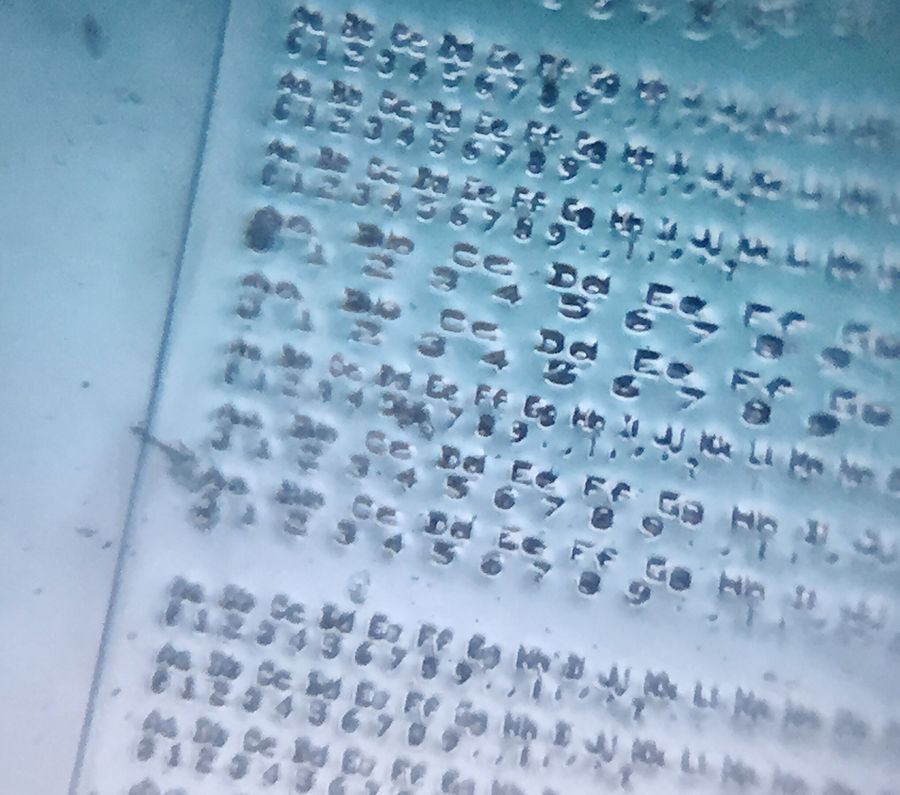
I have been so lucky to meet Prof. Fabian Pease (almost by accident); an emeritus professor at Stanford. We hang out, drink coffee and chat science; and specially discuss “frugal science” and why the world needs scientific tools in the hands of everyone. I have learned so much from Fabian in a short period of time. So I wanted to publicly thank him for what he has already taught me and a lot more to come. So I will weave this story as a history lesson.
A long long time ago (1959 – so not that long ago actually), in a far away land (at Caltech close to LA – so not too far) lived a famous physicist (quiet famous actually). His name was Feynman. You might know him from Feynman diagrams, Feynman lectures in physics, Feynman water sprinkler, Feynman quantum emulators and the list goes on and on. But he is also well known to start a revolution in micro and nanotechnology by delivering a famous lecture (it became famous much later – it was just his usual style lecture) titled “There is plenty of room at the bottom” PDF where he describes the world of small and how we could potentially make machines so small and they would be governed by laws very different from what we make everyday. It was a beautiful insight that has carried the entire field of micro and nanotechnology in the pursuit for the smallest little devices (all the way to atomic devices) and laid some foundations of what came later.
In his style of making jokes and challenging people – he asked high school students to think about writing very very very small (25,000 times smaller to be exact).
A long long time ago (1959 – so not that long ago actually), in a far away land (at Caltech close to LA – so not too far) lived a famous physicist (quiet famous actually). His name was Feynman. You might know him from Feynman diagrams, Feynman lectures in physics, Feynman water sprinkler, Feynman quantum emulators and the list goes on and on. But he is also well known to start a revolution in micro and nanotechnology by delivering a famous lecture (it became famous much later – it was just his usual style lecture) titled “There is plenty of room at the bottom” PDF where he describes the world of small and how we could potentially make machines so small and they would be governed by laws very different from what we make everyday. It was a beautiful insight that has carried the entire field of micro and nanotechnology in the pursuit for the smallest little devices (all the way to atomic devices) and laid some foundations of what came later.
In his style of making jokes and challenging people – he asked high school students to think about writing very very very small (25,000 times smaller to be exact).
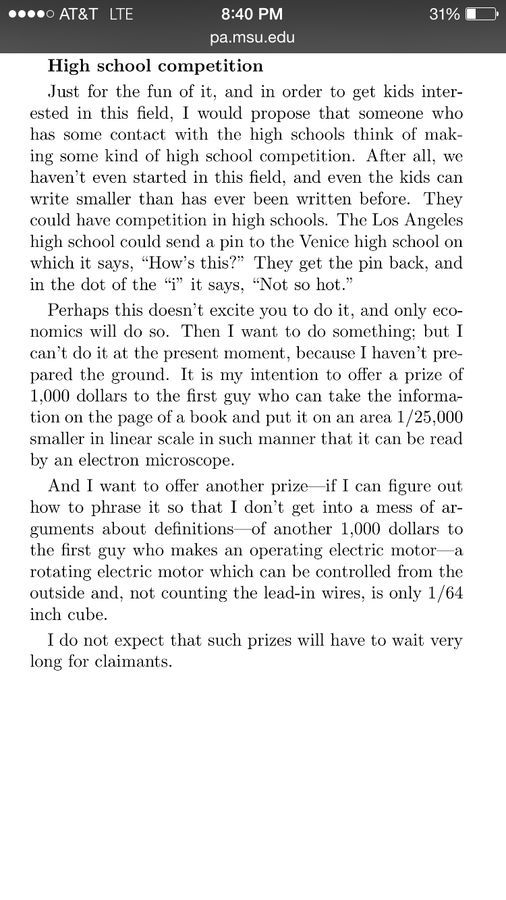
He had thought that people would claim these prizes right away (the motor prize got claimed quickly) but the writing prize had to wait. To be exact, the world had to wait till the autumn of 1985 to be exact. That is 25 long years. That’s a long time on the technology spectrum; but the feat was achieved by a team at Stanford – Tom Newman, a graduate student working with Prof Fabian Pease. Here is some correspondence when Fabian and Tom claimed the prize. You don’t get moments everyday to claim a prize from Feynman..
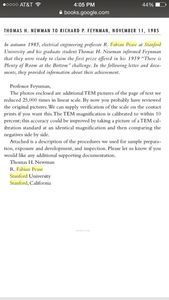
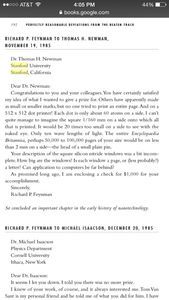
While talking to Fabian, we looked in his stash of things and found some fun old templates. Now – these are much much larger compared to what was submitted for the prize. The 25,000 x linear scale requires a 25,000x magnification (which can only be achieved by a scanning electron microscope). But the idea of writing small text as secret messages is a fun one anyway. So I asked Fabian to give me some small text 🙂 and only if you have a microscope – can you actually read the secret message. Imagine if you passed a note in class – and if you get caught – nobody knows what is actually written on it.
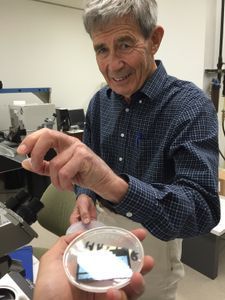
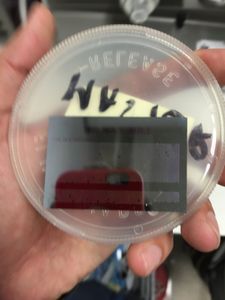
That’s Fabian in the top picture (in his lab – which I try to hang out in). And what he pulled out is the entire bible written on a silicon wafer. Actually both the old and the New Testament. Think about it – I am holding the entire text in the bible in my hand all written in an area smaller than 2 inch by 1 inch.
I also dug and found some text that was templated on a clear polymer. So I could use my foldscope to read the secret message. Here is a picture of the text itself.
I also dug and found some text that was templated on a clear polymer. So I could use my foldscope to read the secret message. Here is a picture of the text itself.
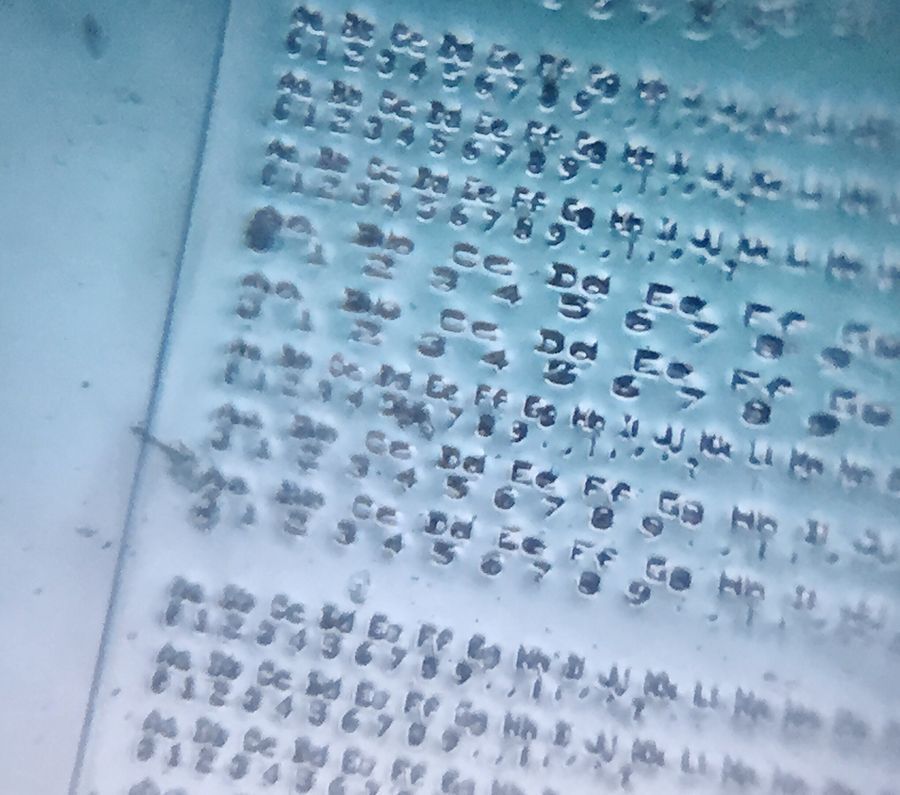
Can you tell what that is. Look carefully. It’s all the letters written in different fonts starting with 123456789 and ABCDEFGH… Can you find them in the image. The image is taken with a 140x low mag foldscope setup.
And just like printing; I can stamp this little hip onto anything and the text will get transferred. So I can make any number of copies that I want. Isn’t that fun – since it’s just like a normal stamp (only smaller).
In my next post; I will add some personal stories from Fabian about the time they decided to take on the challenge and decided to submit the images to Feynman. So watch for my next post for the story behind the Feynman prize.. And why it took so long.
In the mean time, think about how you can send a secret message to your friend by sending small written text so nobody can read it unless he has a foldscope. That’s your secret task. Until next time..
Cheers
Manu
37.5536986 -122.3103295
And just like printing; I can stamp this little hip onto anything and the text will get transferred. So I can make any number of copies that I want. Isn’t that fun – since it’s just like a normal stamp (only smaller).
In my next post; I will add some personal stories from Fabian about the time they decided to take on the challenge and decided to submit the images to Feynman. So watch for my next post for the story behind the Feynman prize.. And why it took so long.
In the mean time, think about how you can send a secret message to your friend by sending small written text so nobody can read it unless he has a foldscope. That’s your secret task. Until next time..
Cheers
Manu
37.5536986 -122.3103295
Sign in to commentNobody has commented yet... Share your thoughts with the author and start the discussion!

 0 Applause
0 Applause 0 Comments
0 Comments
















